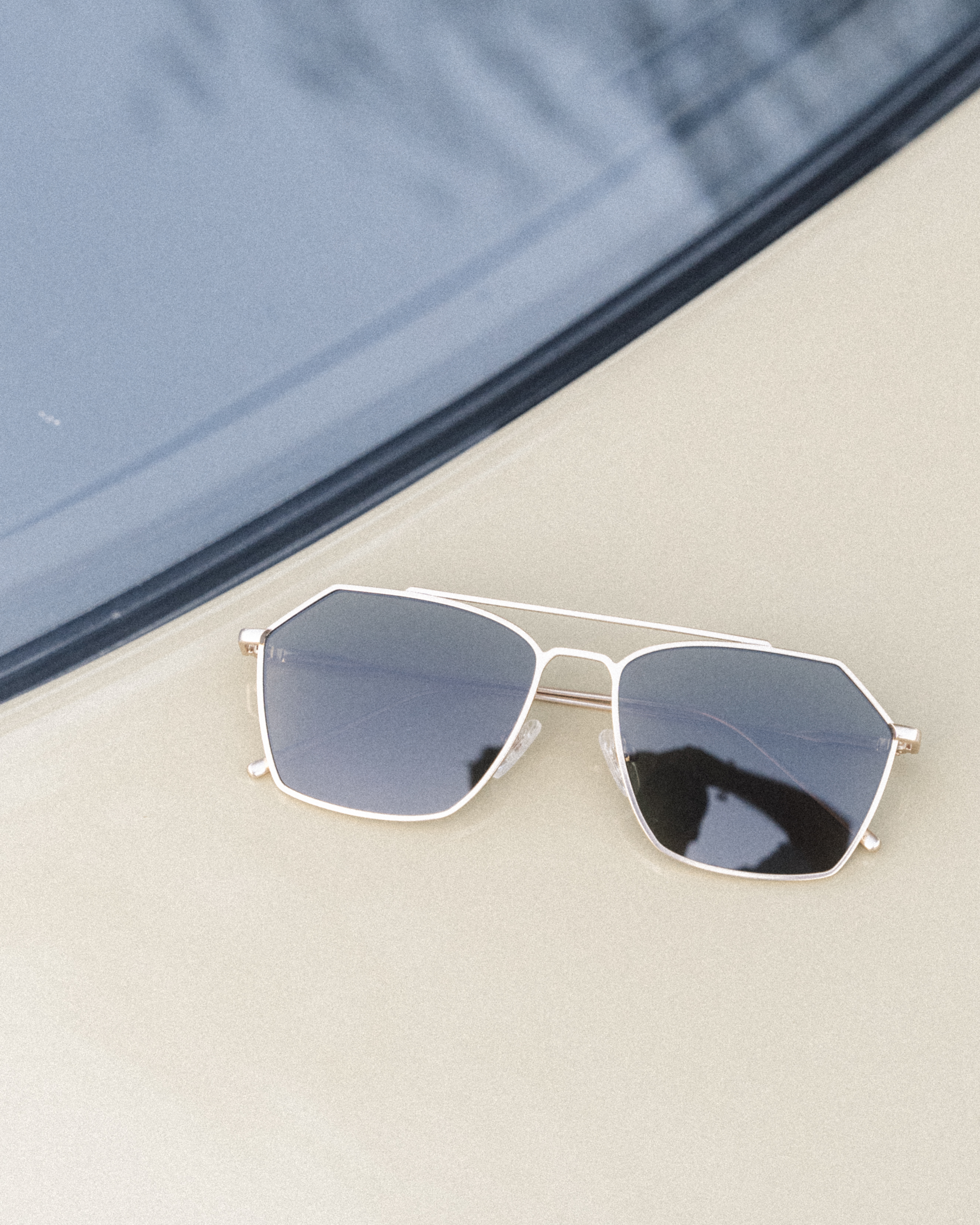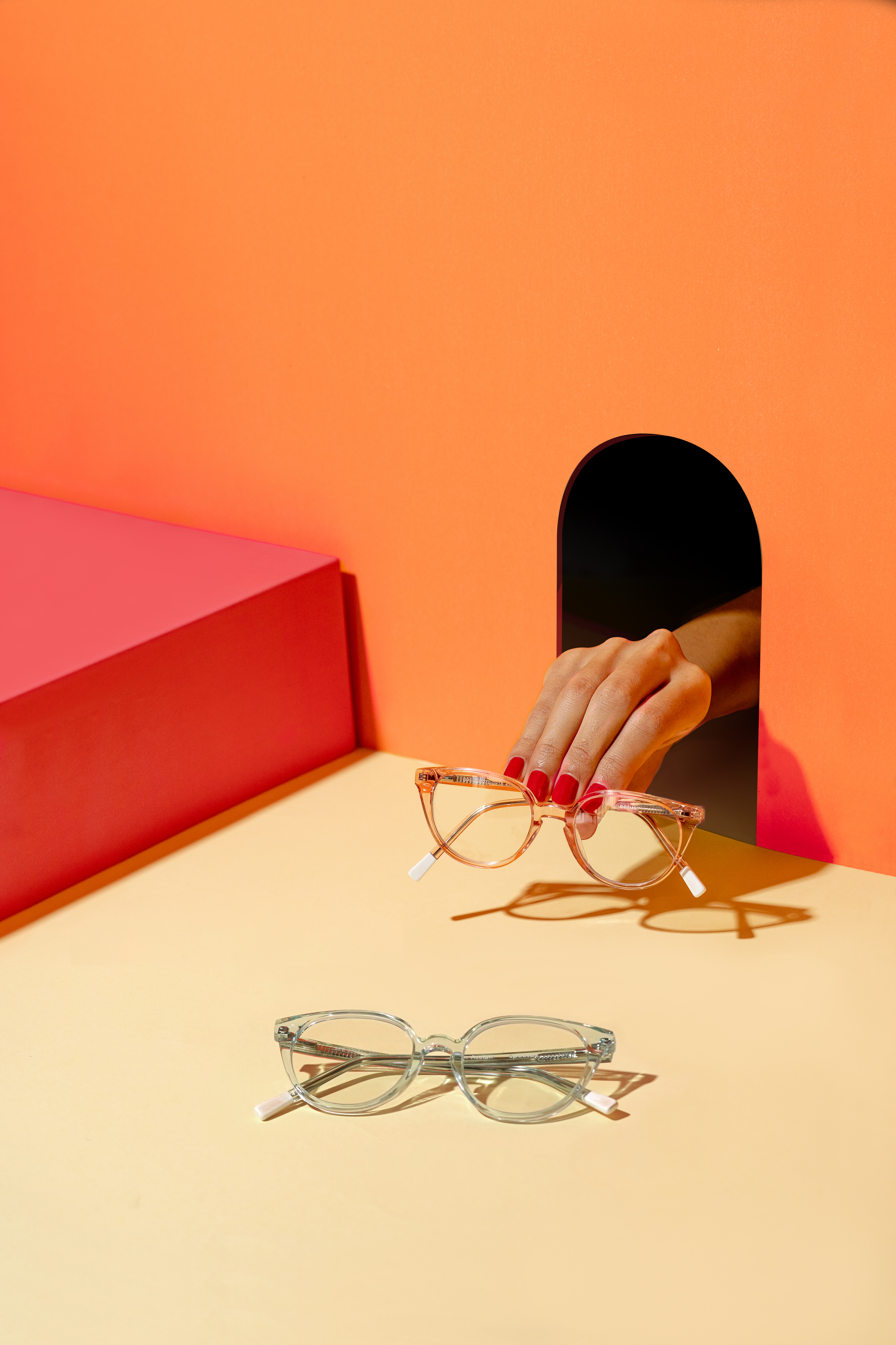The history of sunglasses can be dated back to Ancient Rome. It is said that Emperor Nero would use polished gems while watching gladiator fights. The initial version of sunglasses was also used in China in the 12th century. In China, however, sunglasses were used for an entirely different reason! They were used in court while interrogating witnesses in order to hide people’s expressions. These lenses were designed from smoky quartz. During those times, people were far from having access to technology that would protect the eyes against the harmful UV rays or help in correcting the eyesight.
Experimentation on the tinted glass lenses started around the 18th century by optician and designer James Ayscough who believed that by changing the colour of the lenses to a blue or green tint, he could correct impaired vision. Back in those days, people did not have any knowledge about the harmful effects of the sun’s rays on the eyes. In the late 19th century and the beginning of the 20th century, brown and amber (yellow) tinted glasses were prescribed to people who had syphilis since they had heightened sensitivity to sunlight.
Modern sunglasses started to appear in the 20th century. Sunglasses were sold first at the Atlantic City boardwalk by manufacturer Sam Foster. Soon, they became a popular accessory among the rich and the famous, especially the Hollywood stars. The reason for their popularity was that while shooting, Hollywood stars started wearing them to shield their eyes from the bright studio lights as well as from bright sunlight.
In 1937, when the United States Air Force pilots needed the means to protect their eyes from the bright sun, the aviator style of sunglasses designed by a start-up company Ray-ban was used. Not only did the aviator sunglasses protect the eyes from the harmful UV rays, but they soon became a famous fashion staple during and even after the World War II era. Ray-Ban soon started innovating beyond the aviator and in the’50s with their unique plastic moulding technology, they came up with another classic sunglass style- the ‘Wayfarer’. The plastic moulding technology made designing and manufacturing sunglasses affordable and easy and made them affordable and easily accessible to the general public.
To this date, both Aviators and Wayfarers are amongst the most popular sunglass designs and most designs of sunglasses take inspiration from them.
Polarized sunglasses hit the markets in 1936 when scientist and inventor Edwin. H. Land started using his patented Polaroid filter for making sunglasses. Since their inception, celebrities around the world have been on the fore-front of sunglass trends and sunglasses have become synonymous with Hollywood actors and actresses. Today, there are countless celebrities that own their own designer sunglasses lines and many top brands have sunglasses worn by famous pop stars.
There is no denying the fact that sunglasses are undoubtedly a wardrobe essential and one accessory which can add oomph to an outfit. Having a basic understanding of the sunglass design, fit and features can help a person stand out among the crowd and keep his/her eyes safe from the harmful impact of the sun’s ultraviolet rays.
Non-Prescription Sunglasses: 6 Things To Keep In Mind Before Buying
It is a known fact that sunglasses make it easier to see on a bright sunny day, be it out on the road or in water. The most important feature of sunglasses is their ability to protect the eyes from the harmful ultraviolet rays that can cause short term and long-term eye damage.
Studies suggest that excessive ultraviolet exposure from sunlight could increase the risk of cataracts, skin growths known as pterygiums and several types of cancers. Getting exposed to just a few hours of intense UV rays could cause temporary blindness known as photokeratitis. The risks of harmful UV rays are heightened in children and in people who have light coloured eyes. So, sunglasses are not only a fashion accessory but an ideal tool that helps to keep the eyes safe from harmful ultraviolet rays. Ophthalmologists around the world recommend that sunglasses should have certain essential features that people should keep in mind when they go to buy a pair of sunglasses. Here are some sunglass essentials that should always be considered:
- The bigger, the better: The bigger the coverage area of the sunglasses, the lesser will be the chances of inflicting damage to the eyes. One can consider opting for wraparound-style or oversized glasses to help cut down the amount of UV rays that reach the eyes from the sides.
- Darker doesn’t mean better: Most people believe that the darker the lenses, the higher will be the UV protection. Also, almost everyone finds the dark lenses to be cool. Dark lenses however do not necessarily block more UV rays. Hence it is always best to read the tag or the sticker for dark coloured sunglasses too.
- Colour doesn’t matter: Similarly, the sunglasses that come in colours such as green, grey or amber do not block more rays, but they help in enhancing the contrast and this feature could be useful for sportspersons who play golf or baseball.
- Polarized lenses cut glare, not UV: Polarization is a phenomenon that decreases the glare that comes off various reflective surfaces such as snow, water or pavement. This effect, however, does not offer protection from UV rays. This feature helps in making various activities such as driving or underwater activities more comfortable by cutting down glare. So, polarization should not be confused with UV protection and both the features should be looked at separately.
- Expensive doesn’t always mean better: Sunglasses do not have to be expensive for them to have all the essential features. There are less expensive pairs that are 100 UV blocking and can look and work just as effectively as the pricier ones. So, pricier does not always mean better.
It is important to remember that sunglasses are not just for adults. Children’s eyes being more prone to UV damage need optimal protection and they should be encouraged to wear sunglasses when they spend time outdoors. Sunglasses have undergone an evolution from being a practical tool for protecting the eyes from harmful UV rays to a daily essential that can complement a person’s looks and outfit to a whole new level. Sunglasses are a must-have accessory for any well-dressed individual and should always be a part of his/her closet essentials. It is, however, important to take a close and careful look at the facial features and the face type before buying a pair of sunglasses. Not all shapes suit everyone and hence understanding which shape and fit suits which face type can ensure that the sunglasses complement an individual’s best features.
Men’s Sunglasses: Which Frame Suits Which Face Type?
Picking the right pair of sunglasses for a face type can be a tedious task, especially with the countless designs and styles that are out there in the market. Understanding the basic styles of sunglasses as well as identifying the face shape can make this task a lot easier. When it comes to shapes and designs, sunglass designs fall under these broad categories:
- Round Sunglasses: Round sunglasses have been a statement accessory since the ’90s when people decided to take a break from bolder frames and give minimalistic designs a try. Round sunglasses can be the most difficult to pull off, as they are extremely specific to what face shape they suit best. They are perfect softening sharp jawlines and bold features. They can be recognised easily by their round lenses and frames and their silhouette.
- Square Sunglasses: Contrary to the rounded sunglasses, square sunglasses are characterized by sharper frames. While they may not always be perfectly squared, they are definitely more angular than the rounded sunglasses. This feature helps them to add definition and structure to faces that have subtle cheekbones and round jaws.
- Aviator Sunglasses: Aviators or aviator sunglasses were historically created to protect the pilot’s eyes from the sun during flight. They are an extremely popular sunglasses option and are characterized by their thin metal frames and double bridge. The long shape of aviators helps them elongate the face and balance out features. The design of aviators helps them to hook firmly behind the ears, which is extremely helpful in retaining the frame on the face, no matter what a person is doing.
- 4. D-frame Sunglasses: Characterized by their rounded bottom rims and straight flat edge across the top of the rims, D frame sunglasses are meant to look like the capital letter D. these frames offer the ideal combination between modern and retro, making them extremely stylish and perfect for anyone who is looking for a statement accessory to amplify their look.
Once the understanding of the type of sunglasses is clear, the next step is to identify the face shape. As a general rule, the aviator style or the rounded frame style are best suited for faces with defined cheekbones or strong jawlines. The stronger a man’s facial features, the bigger should be the sunglasses, to strike an optimum balance. Men who have less defined features should stick to small or medium-sized frames. Keeping these essentials in mind, one should always try the sunglasses on before buying. Here are the different face shapes and the sunglasses that are best suited for them:
For Oval Face Shape: Oval face shape is when the length of the face is more than the width of the cheekbones. An oval face shape, the forehead is wider than the jawline, which is relatively rounded men with oval face are the luckiest as the oval shape is the most versatile face shape of all, and this makes these men suitable for all sunglasses styles.
For Square Face Shape: People with square faces have boxy cheekbones and strong jawlines. In these men, the forehead, cheekbones and jawline are somewhat similar in length. Unlike round faces, people with square faces usually have too much definition which needs to be toned down. Therefore, sunglasses that have round rims are ideal for men with square face shape, since the roundness of the rims helps in softening the strong and bold facial features. It is best to opt for small and medium-sized sunglasses which are not too overwhelming on the face.
For Rectangle Face Shape: Just like the square face shape, people with rectangle face shape have strong boxy cheekbones and jawlines. The only major difference is that p]in people with rectangle face shape, the length of the face is smaller. Therefore, men with this face shape should opt for sunglasses that help in creating a balance to their face shape and help in softening the sharp lines. it is best not to extend beyond the widest part of the face and to stay away from sunglasses that have sharp lines.
For Round Face Shape: For people with round face shape, the angle of the jaw is not defined. Men with this face shape tend to have wider face widths and larger cheekbones. The angle of the jaw is not well defined and cheekbones are larger with wider face widths which are almost symmetrical in size. Also, they have a smaller forehead and jawline, which tend to be symmetrical. People with a round face should choose sunglasses that add more definition to their face. Sunglasses that work best for round faces and slim the cheeks are the ones that are angular and are a bit larger than the face. The best choice for men with round face shape is square style sunglasses. It is best to stay away from round frames, instead, D-frames can be the second choice as they have a straight top rim but around bottom rim.
For Diamond Face Shape: For people who have a diamond-shaped face, the size of features funnels down. The face length is the longest which is followed in descending order by cheekbones, forehead and jawline. They have pointed chin, creating a diamond-shaped appearance. The chin is pointed, creating that “diamond” appearance. D-frame sunglasses are best suited for diamond face shapes since the balance between round rims and straight edge helps in balancing out the overall shape of the face. Men with a diamond-shaped face should pick lenses that are smaller in size since the top of the face is already wide and does not need any more attention.
For Heart Face Shape: Men who have heart face shapes have pointier chins than any other dimension of the face. Their forehead is broader than the cheekbones. The sunglasses that are best suited for heart face shape are those that help in creating a balance between the smaller jaw and the larger forehead. Small to medium-sized sunglasses are ideal for this face shape and sunglasses such as aviators and D-frame sunglasses are a great choice as they add length to the face. Round styles should be avoided since they will add too much emphasis on the forehead.
For Triangle Face Shape: Men who have a triangular face shape a very small forehead, small cheekbones and large jawlines. Since in men with a triangle face shape, there is more definition at the bottom of the face, so larger sunglasses are a great choice as they will help in balancing the top of the face. Small frames are best avoided as they will draw too much attention to the lower portion of the face. Other than the scale, triangle face shape tends to give a person free range on what style of the frame he can wear.
Finding an ideal pair of sunglasses can be a bit hard but the results are definitely worth it. Understanding the face shape and then picking the sunglasses that complement that shape can make all the difference.
Now that our basic concepts of sunglasses, their features and styles as well as the face types are crystal clear, let us take a look at the hot sunglass trends for 2020.
Top Sunglass Trends For 2020
With the new year kicking in, a whole new decade of fashion has set in. This means the designs are going to be edgier, trendier and better than ever. With the Summer round the corner, this is the right time to stay updated about the chicest sunglass trends for this year. So, here are the upcoming sunglass trends to look forward to in 2020. The trends for this year are quite unique from retro round shapes to futuristic structured frames. Here are some of our favourite ones:
- The New Tiny Frames: For 2020, tiny frames have become a bit more pronounced. Time to say goodbye to the barely-there wireframes and opt for a more vintage look with an acetate frame which promises to add more weight to the micro minis.
- Flat-Tops: The popular futuristic aviator sunglass trend has undergone refinement for this year with oversize frames which were once considered ultra-feminine. For a sportier vibe, opt for a totally flat top of the frame.
- Bright White: For those looking for sunglasses that will add a little more oomph and yet look just as classic and neutral, bright white frames are an ideal match. So, choose from any of the trendy styles — aviator, oversize, tiny and more. Just make sure to pick a style in a clean white tone that really pops.
- Futuristic Structure: Futuristic sunglasses have been one of the trendiest designs for the past few seasons. This year brings futuristic sunglasses with a new twist. Instead of going with the sportier styles, try the ones that have something extra to offer when it comes to silhouette and shape, such as spoked cat eye, or an exaggerated size.
- Thick, Oversize Frames: Even though the micro-mini sunglass frames have infiltrated the market, the oversized frames are back with a vengeance. This is one sunglass trend that is here to stay for a very long time.
- Retro Round: For those who are looking to have a bit of fun with their sunglasses in 2020, true retro style sunglasses with a large round frame are a great option. The trends include scalloped to the classic tortoise to clear ones.
- Cat-eye sunglasses with a twist: Due to their flattering shape that pulls up the face and emphasises the cheekbones, cat-eye frames are here to stay. This year, this classic sunglass staple is back in funkier varieties. These classic vintage-style sunglasses have been given an overdue update with unique finishes, bright colours and bold details. Try them out in a bold colour or a finely designed style.
- Geometric sunglasses: To stand out from the rest of the crowd, geometric designs are the best bet. From hexagonal to square, the variations in the geometric sunglasses add an eye-catching element to any outfit. Their bold shape helps in sharpening the facial features and give an ultra-chic vibe.
- Bejewelled sunglasses: For an ultimate girly chic accessory, bejewelled frames are the ideal choice. Being extra opulent and extra glam, the bejewelled trend is a fun way to dress up a look. For a Hollywood movie star look, subtle bling embellishments work wonders. Sparkling embellishments and tiny rhinestones help this sunglass trend stand out from the crowd. Depending on how bold one would want the look to be, one can choose from different frame styles and colours.
- Brow bar sunglasses: This bold take on the aviator is one trend that is here to stay! They are easy to admire and impossible to ignore. One of the favourites looks from recent runways, the top bar frame has evolved into a wide range of styles that help in giving the classic aviator sunglasses a modern twist. The addition of a brow bar is sure to give any pair of sunglasses a bit of attitude. To add boldness to any outfit, brow bar frames are the ideal choice. So go ahead and try out these super trendy and chic sunglasses this year and uptake that glam quotient game a few notches higher!
People who have refractive errors are sometimes hesitant to buy sunglasses as they need to keep their prescription glasses on at all times or wearing non-prescription sunglasses along with contact lenses sometimes becomes a hassle. Also, the need to carry clip-on lenses and magnetically attached sun lenses can become quite annoying. For them, prescription sunglasses are just the right choice. So, what exactly are prescription sunglasses? Read on to find out.
Our Guide To Prescription Sunglasses
Prescription sunglasses are sunglasses that are fitted with lenses of a person’s corrective prescription. They are a great choice for people with refractive errors as they can protect the eyes from glare and sunlight while enabling a person to see clearly. Prescription sunglasses are available for nearly all types of refractive errors and have several options such as progressive lenses and bifocal lenses. Many people find prescription sunglasses to be a great option for ensuring clear vision along with having the luxury of shade from bright sunlight. People who spend a considerable amount of time outdoors, or who drive a lot can benefit greatly from prescription sunglasses, making outdoor activities much safer and easier for their eyes.
In addition to being fashionable, prescription sunglasses offer countless other benefits. Here are some reasons why prescription sunglasses are a great choice:
- Enhanced focus and comfort while driving: People who spend a lot of time driving, often find it quite hard to keep looking for those magnetically attached sun lenses or clip-on lenses while they are behind the well. Such distractions could also make driving unsafe and increase the risk of accidents. This is where prescription sunglasses come in handy as they make driving convenient, safe and more hassle-free.
- A great option for outdoor activities: People who wear contact lenses often find that prescription sunglasses serve as a more practical alternative for outdoor activities. For example, on the beach, contact lenses tend to make the eyes watery and itchy due to effects of the wind, sand and water and can ruin what would have been an otherwise great day outdoors. Even the non-prescription sunglasses that people wear over their contact lenses do not provide the ideal protection from the harmful rays of the sun. Wearing contact lenses while swimming is again a bad idea as it increases the risk of potentially serious eye infections from microorganisms in the water. With prescription sunglasses, there is always an option of wearing them outdoors for long hours without having to deal with contact lenses or looking for clip-on sunglasses.
- Available for all prescriptions: Prescription sunglasses are available for almost every lens prescription, including progressive lenses and bifocal lenses. They are also available as prescription swimming goggles and are a great option for swimmers.
- Countless frame styles to choose from: The style options for prescription sunglass frames are nearly the same as for non-prescription sunglasses. Prescription sunglasses are available in almost all designer, fashion and celebrity eyewear styles. The only time where availability is limited is for certain wraparound sunglasses that curve around the head. This is because when prescription sunglasses are designed with extreme curves, it distorts the vision completely. However, there are certain manufacturers that design wraparound prescription sunglasses which have less extreme curves. These are available in a limited prescription range, so one needs to discuss options with the optician.
- Wide range of lens options: Nowadays, prescription sunglasses are available in all types of lens materials, such as polycarbonate, regular (CR-39) plastic, high index, glass and Trivex (a lightweight material that is similar to polycarbonate) . Although lenses made from glass provide the best quality of vision, they are no longer the most popular option for prescription sunglasses. This is because glass lenses are much heavier as compared to other lens material and they break easily. Photochromatic lenses are another option in prescription sunglasses. These lenses have a photochromic tint and they darken automatically in bright sunlight and return to a clear state when indoors. Although photochromatic lenses are very convenient, they have a drawback. To activate the tint, these lenses require ultraviolet light (UV). Since most windshields block UV significantly, these lenses do not darken very well inside the car. For eyewear that is suitable for all kinds of lighting conditions, some opticians recommend a frame integrated magnetic clip-on sunglasses along with photochromatic lenses. The photochromatic lenses help with light adjustments for better comfort while outdoors and the clip-on sunglasses can be reserved for bright sunny days that require darker lenses.
- Glare and UV protection: Just as with prescription sunglasses, a major concern when choosing prescription sunglasses is that they should be able to block out all the harmful UV rays. The UV protection is unrelated to the density of the tint and the colour of the sunglass lenses, as long as it is verified by the optician that these lenses provide a 100 per cent protection from UV rays. For added protection against UV rays and to keep light from bouncing back off the reflective surfaces (sand, water, concrete pavement and snow) there is the option of prescription polarized sunglasses that keep the glare away.
- Cost effective: There are many online eyewear retailers that offer special discounts and great deals on prescription sunglasses and have countless varieties of styles to choose from.
So, for all those who have been looking for a reason to try out prescription sunglasses, there are many benefits of wearing prescription sunglasses with absolutely no harm to the vision or the comfort level. Try these sunglasses while outdoors, at the beach, during a long sunny drive or while enjoying a dip in the pool. With so many designs, styles and features to choose from, why should people with refractive errors have to miss out on looking chic, hot and trendy this summer season!






